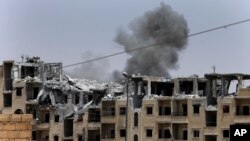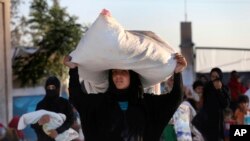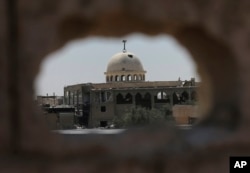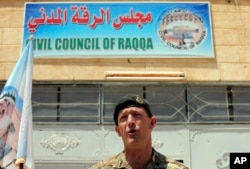Thousands of civilians trapped in Raqqa, in northern Syria, are under an increasing risk of death because of attacks from all sides as the battle for the Islamic State's self-proclaimed capital enters its final stages, Amnesty International says in a new report.
The Islamic State (IS) is known to have used civilians as human shields and to have shot and killed Raqqa residents trying to flee the city. But the U.S.-led coalition, alongside the Syrian Democratic Forces (SDF) and the Syrian regime, supported by Russian warplanes, have been responsible for many causalities in the “deadly labyrinth” of being fired upon from all sides in the city, Amnesty International said in a report issued Thursday.
“Things will only get more dangerous as the battle reaches its final stages in the city center,” Donatella Rovera, Amnesty International's senior crisis response adviser, told VOA. “More can and must be done to preserve the lives of civilians trapped in the conflict and to facilitate their safe passage away from the battleground.”
Civilian casualties
Amnesty's account comes as Syrian monitoring groups continue to report civilian casualties in Raqqa's populated neighborhoods after intense coalition airstrikes.
The Britain-based Syrian Observatory for Human Rights on Monday said coalition airstrikes in the city killed at least 42 civilians, including 19 children and 12 women.
The U.S.-led coalition has neither denied nor confirmed the rights group's claims.
The U.S.-backed SDF group has made significant gains against IS militants as the fighting reaches the more densely populated neighborhoods of the terror group's Syrian stronghold.
The U.S.-led coalition estimates there are about 2,500 IS fighters who still control about 45 percent of the city.
Meanwhile, the Syrian government forces, which receive air support from Russia, are pushing against the extremists in the countryside south of the city.
It is unknown how many civilians remain trapped in Raqqa and the southern countryside, but the United Nations estimated 25,000.
IS snipers and booby traps
The 33-page report, released by Amnesty International on Thursday, said those civilians will face IS booby traps and snipers if they try to flee.
Meanwhile, civilians risk a constant barrage of artillery strikes and airstrikes by the U.S.-led coalition forces fighting alongside SDF if they remain in the city.
Outside Raqqa, in an area south of the Euphrates River, Syrian government forces and Russian warplanes have been launching indiscriminate air bombardments against IS-controlled towns and villages, including using internationally banned cluster bombs, the report added.
The organization urged warring parties to prioritize protecting civilians and creating safe corridors for them to flee. It urged the U.S. and other anti-IS coalition members to be more transparent about information on their airstrikes and review the effectiveness of their civilian casualty prevention and mitigation processes.
“The ones we hope will listen and take measures to protect civilians are the coalition forces,” Rovera told VOA. “They have the means to do that.”
US-led coalition stance
The coalition has not denied reports about casualties that result from airstrikes, but it has said protecting civilians has been its priority in fighting in Raqqa and other areas across Syria and Iraq.
British Army Maj. Gen. Rupert Jones, the deputy commander for the U.S.-led coalition, told reporters Wednesday that coalition jets go to "extraordinary lengths" to minimize civilian casualties when conducting airstrikes.
“We regret civilian casualties enormously, but the people who focus on civilian casualties more than anybody are the West,” Jones said during a teleconference briefing from Baghdad.
He added that civilians in those areas were more accepting of the causalities caused by the coalition airstrikes and bombardment from its allied militant groups because they understand “sacrifices that are required to achieve your freedom.”
“But this is a war. It's not a war of our choosing. ... But if you want to liberate your towns and cities, it comes at a price. Our job is to ensure that price is as small as possible,” Jones added.
Some casualties inevitable
Rovera, of Amnesty International, told VOA that some of the casualties in populated areas were inevitable, but she said that the U.S.-led coalition needed to be more accurate in targeting IS positions.
She said most of civilian casualties from the U.S.-led coalition were because the ammunition being used was not precise enough and had wide-impact radii.
“These things can be addressed. They can be fixed,” she said.









